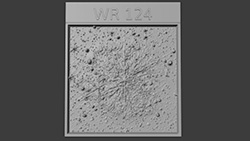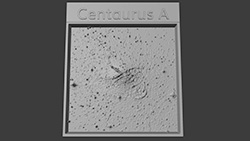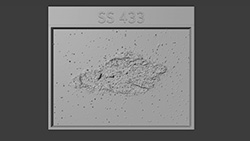CXC Home | Search | Help | Image Use Policy | Latest Images | Privacy | Accessibility | Glossary | Q&A
1
X-ray, Optical, & Infrared ImagesSonification Credit: NASA/CXC/SAO/K.Arcand, SYSTEM Sounds (M. Russo, A. Santaguida)
This trio of sonifications represents different aspects of black holes and black hole evolution. WR124 is an extremely bright, short-lived massive star known as a Wolf-Rayet that may collapse into a black hole in the future. SS 433 is a binary, or double system, containing a star like our Sun in orbit with either a neutron star or a black hole. The galaxy Centaurus A has an enormous black hole in its center that is sending a booming jet across the entire length of the galaxy. Data from Chandra and other telescopes were translated through a process called “sonification” into sounds and notes. [Listen to the sonifications here].
2
3D Printable Files: WR 124 (3D Print Credit: NASA/CXC/A. Jubett, using software by Tactile Universe/N. Bonne & C. Krawczyk & Blender)
This tactile plate is a physical relief map based on the intensity of X-ray and infrared data. In this composite plate, a prominent, massive star, WR 124, sits like a snowflake in the center of 6 diffraction spikes, surrounded by a churning wind cloud. The combination of the wind cloud with the spikes, dots and tangles of wisps resembles a puffy dandelion that has gone to seed. Dozens of other prominent stars surround WR 124, including dots rimmed with mounds of light, and other dots with raised diffraction spikes. The mounded dots are stars detected with Chandra.
3D Printable Files: Centaurus A
(3D Print Credit: NASA/CXC/A. Jubett, using software by Tactile Universe/N. Bonne & C. Krawczyk & Blender)
(3D Print Credit: NASA/CXC/A. Jubett, using software by Tactile Universe/N. Bonne & C. Krawczyk & Blender)
This tactile plate is a physical relief map based on the intensity of X-ray and optical data. In this composite plate, a supermassive black hole at the center of the Centaurus A galaxy shoots an enormous jet of particles into a star-packed sky. Here, Centaurus A resembles layers of streaky clouds. At the heart of the combined cloud structure is the black hole, a protruding dot that lights the clouds from within. The jet emerges from this dot, a speckled beam shooting toward our upper left. Surrounding the entire galaxy is a bubble shape, which is most pronounced at our lower right. This bubble was created by the jets from the black hole. Both the jets and the bubble are detected by Chandra.
3D Printable Files: SS 433
(3D Print Credit: NASA/CXC/A. Jubett, using software by Tactile Universe/N. Bonne & C. Krawczyk & Blender)
(3D Print Credit: NASA/CXC/A. Jubett, using software by Tactile Universe/N. Bonne & C. Krawczyk & Blender)
This tactile plate is a physical relief map based on the intensity of X-ray data (from Chandra, IXPE and XMM-Newton) along with radio and infrared data, featuring a binary star system at the center of a supernova remnant known as the Manatee Nebula. The raised, puffy area does resemble a bulbous walrus or manatee, floating in less dense haze packed with distant specks. Inside the nebula lie a couple of streaks and a large raised dot. The dot is the binary system at the heart of the puffy nebula.
Return to: NASA Telescopes Tune Into a Black Hole Prelude, Fugue (May 8, 2025)























